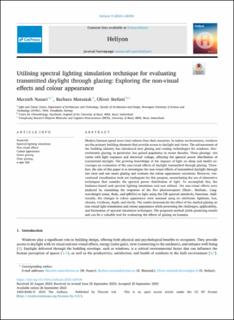| dc.description.abstract | Modern humans spend more time indoors than their ancestors. In indoor environments, windows are the primary building elements that provide access to daylight and views. The advancement of the building industry has introduced new glazing and coating technologies for windows. Electrochromic glazing, in particular, has gained popularity in recent decades. These glazings’ tint varies with light exposure and electrical voltage, affecting the spectral power distribution of transmitted daylight. The growing knowledge of the impacts of light on sleep and health encourages an evaluation of the non-visual effects of daylight transmitted through glazing. Therefore, the aim of this paper is to investigate the non-visual effects of transmitted daylight through one clear and one smart glazing and evaluate the colour appearance variations. However, conventional visualisation tools are inadequate for this purpose, necessitating the use of alternative techniques that consider the spectral power distribution of light. To accomplish this, the Radiance-based Lark spectral lighting simulation tool was utilised. The non-visual effects were analysed by examining the responses of the five photoreceptors (Short-, Medium-, Long-wavelength cones, Rods, and ipRGCs) to light using the CIE spectral sensitivity functions. Additionally, the changes in colour appearance were assessed using six attributes: lightness, hue, chroma, vividness, depth, and clarity. The results demonstrate the effect of the studied glazing on non-visual light stimulation and colour appearance while presenting the challenges, applicability, and limitations of spectral simulation techniques. The proposed method yields promising results and can be a valuable tool for evaluating the effects of glazing on humans. | en_US |

